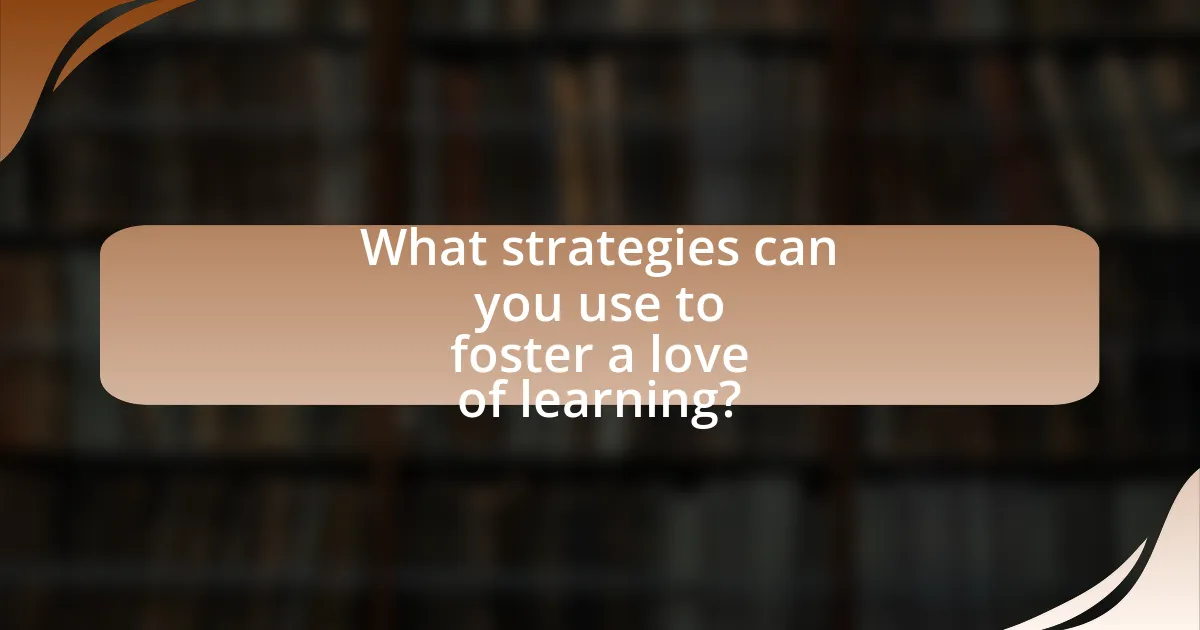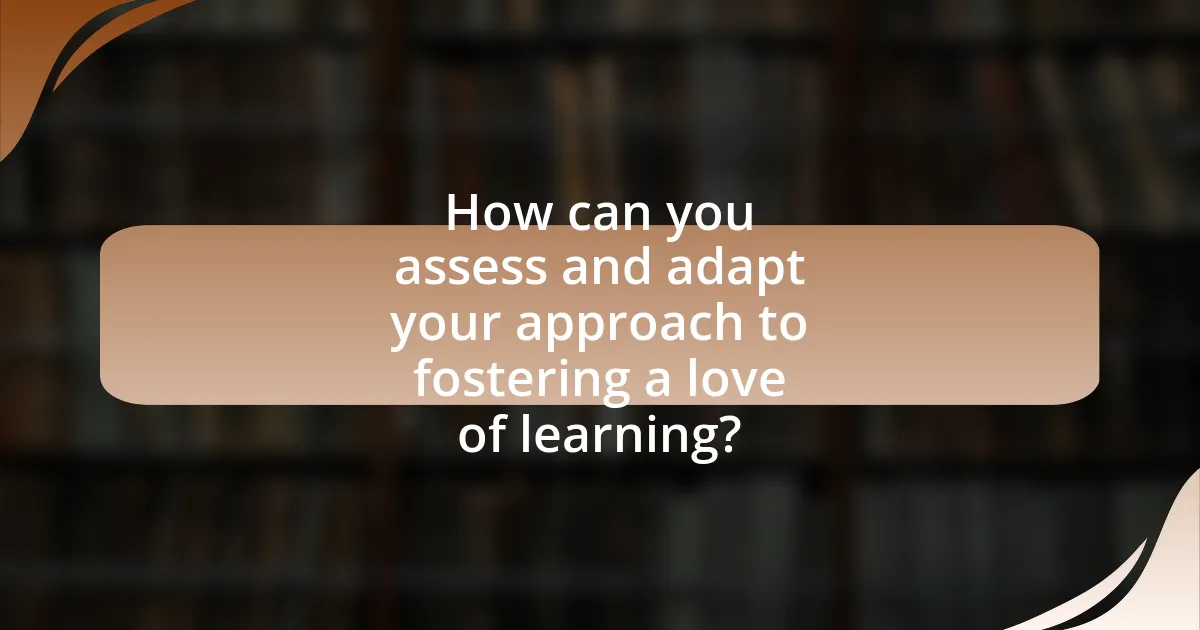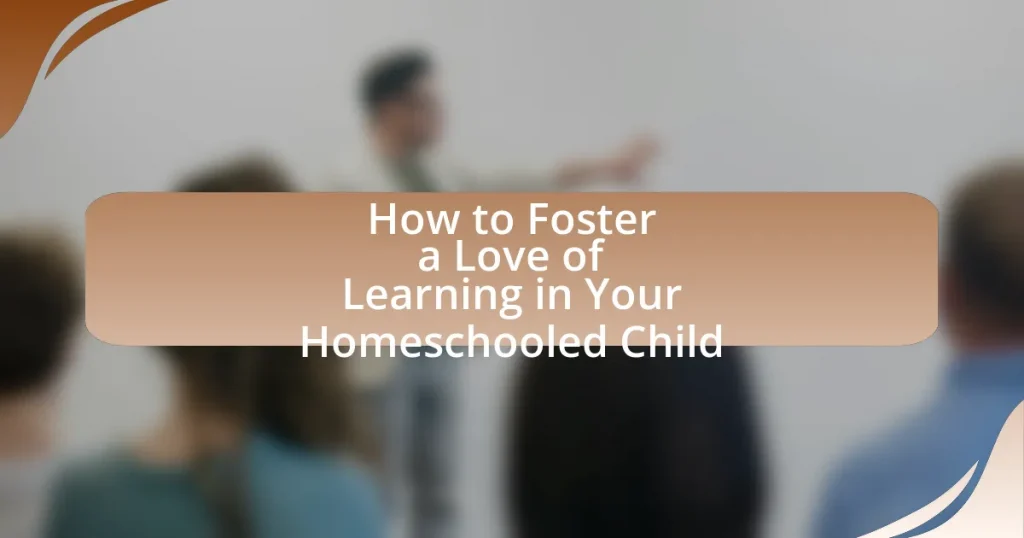The article focuses on strategies to foster a love of learning in homeschooled children, emphasizing the importance of creating an environment that nurtures curiosity and intrinsic motivation. It discusses the impact of a positive home environment, parental attitudes, and hands-on activities on a child’s educational engagement and long-term success. Key research findings highlight the correlation between intrinsic motivation and academic achievement, as well as the benefits of personalized learning approaches. The article also provides practical tips for integrating learning into everyday activities and celebrating milestones to reinforce a child’s enthusiasm for education.

What does it mean to foster a love of learning in your homeschooled child?
Fostering a love of learning in your homeschooled child means creating an environment that encourages curiosity, exploration, and a passion for knowledge. This involves providing diverse educational resources, allowing for self-directed learning, and integrating real-world experiences that connect learning to everyday life. Research indicates that children who engage in hands-on activities and have the freedom to pursue their interests are more likely to develop intrinsic motivation for learning, as highlighted in studies by the National Center for Education Statistics, which show that personalized learning approaches can enhance student engagement and achievement.
How can fostering a love of learning impact your child’s education?
Fostering a love of learning significantly enhances a child’s education by promoting intrinsic motivation and engagement in the learning process. When children are excited about learning, they are more likely to explore subjects deeply, retain information better, and develop critical thinking skills. Research indicates that students who exhibit a passion for learning tend to achieve higher academic performance; for instance, a study published in the Journal of Educational Psychology found that intrinsic motivation correlates positively with academic success and persistence in challenging tasks. This intrinsic motivation leads to a more profound understanding of concepts and a lifelong appreciation for education.
What are the long-term benefits of a love of learning?
A love of learning fosters lifelong intellectual curiosity, leading to continuous personal and professional growth. Individuals who embrace learning tend to adapt better to changes in their environment, enhancing their problem-solving skills and creativity. Research indicates that lifelong learners are more likely to pursue advanced education and training, which correlates with higher earning potential and job satisfaction. For instance, a study by the Pew Research Center found that adults who engage in continuous learning are 20% more likely to report being satisfied with their careers. Additionally, a love of learning contributes to improved mental health, as it encourages engagement and social interaction, reducing feelings of isolation and depression.
How does a love of learning influence a child’s motivation?
A love of learning significantly enhances a child’s motivation by fostering intrinsic interest in acquiring knowledge and skills. When children are passionate about learning, they are more likely to engage actively in educational activities, seek out new information, and persist through challenges. Research indicates that intrinsic motivation, driven by a genuine interest in the subject matter, leads to deeper understanding and better retention of information. For instance, a study published in the Journal of Educational Psychology by Deci and Ryan (2000) highlights that students who find joy in learning are more likely to take initiative in their education and achieve higher academic performance. This intrinsic motivation creates a positive feedback loop, where the joy of learning fuels further exploration and curiosity.
Why is it important to cultivate a love of learning at home?
Cultivating a love of learning at home is crucial because it fosters intrinsic motivation and lifelong learning habits in children. When children develop a passion for learning, they are more likely to engage deeply with educational material, leading to better academic performance and critical thinking skills. Research indicates that children who enjoy learning are more likely to pursue knowledge independently, which enhances their ability to adapt to new challenges and environments. For instance, a study published in the Journal of Educational Psychology found that students who reported a strong interest in learning were more successful in their academic pursuits and exhibited higher levels of creativity and problem-solving skills.
What role does the home environment play in a child’s learning?
The home environment significantly influences a child’s learning by providing the foundational context in which educational experiences occur. A nurturing and stimulating home environment fosters curiosity, motivation, and engagement in learning activities. Research indicates that children who grow up in supportive and resource-rich environments tend to perform better academically. For instance, a study published in the “Journal of Educational Psychology” by Dearing, McCartney, and Taylor (2006) found that children exposed to a positive home learning environment, characterized by parental involvement and access to educational materials, showed higher cognitive development and academic achievement. Thus, the home environment plays a crucial role in shaping a child’s learning trajectory.
How can parental attitudes affect a child’s perception of learning?
Parental attitudes significantly influence a child’s perception of learning by shaping their motivation and engagement. When parents exhibit a positive attitude towards education, children are more likely to develop a love for learning, as they perceive it as valuable and enjoyable. Research indicates that children whose parents express enthusiasm for learning tend to have higher academic achievement and greater intrinsic motivation (Gonzalez-DeHass et al., 2005). Conversely, negative parental attitudes can lead to anxiety and disinterest in educational activities, as children may internalize their parents’ beliefs about the difficulty or unimportance of learning. Thus, the way parents approach education directly impacts how children view and engage with their own learning experiences.

What strategies can you use to foster a love of learning?
To foster a love of learning, create a stimulating and engaging environment that encourages curiosity and exploration. This can be achieved by incorporating hands-on activities, allowing children to pursue their interests, and providing access to diverse resources such as books, educational games, and technology. Research indicates that children who are given choices in their learning process are more motivated and engaged; for example, a study published in the Journal of Educational Psychology found that autonomy in learning significantly enhances intrinsic motivation. Additionally, celebrating achievements, no matter how small, reinforces positive learning experiences and builds confidence.
How can you create a stimulating learning environment at home?
To create a stimulating learning environment at home, establish a dedicated, organized space for learning that is free from distractions. This space should be equipped with necessary materials such as books, art supplies, and technology to facilitate various learning activities. Research indicates that a well-defined learning area can enhance focus and productivity, as noted in studies by the American Psychological Association, which highlight the importance of environment in educational outcomes. Additionally, incorporating diverse learning resources and interactive activities can further engage children and foster a love of learning.
What materials and resources can enhance your child’s learning experience?
Educational materials and resources that can enhance a child’s learning experience include interactive books, educational games, online courses, and hands-on learning kits. Interactive books engage children through activities that promote critical thinking and comprehension skills, while educational games make learning fun and reinforce concepts through play. Online courses provide access to a wide range of subjects and expert instruction, allowing for personalized learning at the child’s own pace. Hands-on learning kits, such as science experiment sets or art supplies, encourage creativity and practical application of knowledge. Research shows that diverse learning materials cater to different learning styles, which can significantly improve retention and understanding. For instance, a study published in the Journal of Educational Psychology found that students who used varied instructional materials performed better academically than those who relied on traditional textbooks alone.
How can you incorporate hands-on activities into your homeschooling routine?
Incorporating hands-on activities into your homeschooling routine can be achieved by integrating practical projects, experiments, and real-world applications of concepts being taught. For example, when teaching science, conducting simple experiments, such as growing plants or creating chemical reactions, allows children to engage directly with the material. Research indicates that experiential learning enhances retention and understanding; a study by the National Training Laboratories found that hands-on activities can lead to a retention rate of up to 75%, compared to 5% for lectures. Additionally, using everyday tasks like cooking to teach math and measurements can make learning relevant and enjoyable.
What role does curiosity play in fostering a love of learning?
Curiosity is essential in fostering a love of learning as it drives individuals to seek knowledge and explore new ideas. When children are curious, they engage more deeply with their learning experiences, leading to increased motivation and retention of information. Research indicates that curiosity enhances cognitive processes, such as critical thinking and problem-solving, which are vital for effective learning. For instance, a study published in the journal “Science” by Gruber et al. (2014) found that curiosity not only promotes exploration but also enhances memory retention, demonstrating its significant role in the learning process.
How can you encourage your child to ask questions and explore?
Encouraging your child to ask questions and explore can be achieved by creating an open and supportive environment that values curiosity. When parents actively listen to their child’s inquiries and respond thoughtfully, it reinforces the importance of questioning. Research indicates that children who feel their questions are valued are more likely to engage in exploration and critical thinking. For instance, a study published in the Journal of Educational Psychology found that children who are encouraged to ask questions demonstrate higher levels of engagement and learning outcomes. Providing opportunities for hands-on activities and real-world experiences also stimulates curiosity, as children learn best through exploration and discovery.
What techniques can help nurture your child’s natural curiosity?
To nurture your child’s natural curiosity, engage them in open-ended questions and hands-on activities. Open-ended questions stimulate critical thinking and encourage children to explore their thoughts and ideas, while hands-on activities allow them to experiment and discover through direct experience. Research indicates that children learn best when they are actively involved in the learning process, as demonstrated in studies by the National Association for the Education of Young Children, which highlight the importance of play-based learning in fostering curiosity and cognitive development.

How can you assess and adapt your approach to fostering a love of learning?
To assess and adapt your approach to fostering a love of learning, regularly evaluate your child’s interests and engagement levels through observation and feedback. This can be done by tracking their enthusiasm for various subjects, noting which activities spark curiosity, and soliciting their input on learning methods. Research indicates that children who are actively involved in shaping their learning experiences are more likely to develop a positive attitude towards education. For instance, a study by the National Center for Education Statistics found that student engagement significantly correlates with academic success. By adjusting your teaching strategies based on these assessments, such as incorporating more hands-on activities or integrating topics of personal interest, you can create a more tailored and effective learning environment that nurtures a lifelong love of learning.
What signs indicate that your child has developed a love of learning?
Signs that indicate your child has developed a love of learning include their curiosity, enthusiasm for new topics, and eagerness to ask questions. When children exhibit a desire to explore subjects independently, such as seeking out books or resources on their own, it demonstrates their intrinsic motivation to learn. Additionally, if they show excitement when engaging in educational activities or discussions, this reflects a positive attitude towards learning. Research indicates that children who actively participate in their learning process tend to retain information better and develop critical thinking skills, further validating these signs as indicators of a love for learning.
How can you measure your child’s engagement and enthusiasm for learning?
You can measure your child’s engagement and enthusiasm for learning by observing their participation in activities, their willingness to ask questions, and their excitement about new topics. Engaged children often show curiosity, demonstrate persistence in problem-solving, and express joy when completing tasks. Research indicates that children who are actively involved in their learning process tend to perform better academically and develop a more positive attitude towards education. For instance, a study published in the Journal of Educational Psychology found that students who exhibit high levels of engagement are more likely to achieve higher grades and have a greater interest in learning overall.
What adjustments can you make if your child shows disinterest in learning?
To address a child’s disinterest in learning, parents can adjust their teaching methods by incorporating more hands-on activities and real-world applications. Research indicates that children engage more effectively when they can connect learning to their interests and experiences. For example, using project-based learning or integrating subjects like science with cooking can make lessons more relatable and enjoyable. Additionally, varying the learning environment, such as taking lessons outdoors or using educational games, can stimulate interest. A study by the National Center for Education Statistics found that interactive learning approaches significantly enhance student engagement and motivation.
What are some common challenges in fostering a love of learning?
Common challenges in fostering a love of learning include lack of motivation, limited resources, and external pressures. Lack of motivation can stem from a child’s disinterest in subjects or a perception that learning is tedious, which can hinder engagement. Limited resources, such as insufficient access to diverse educational materials or experiences, can restrict opportunities for exploration and discovery. External pressures, including high expectations from parents or societal norms, can create anxiety and diminish a child’s intrinsic desire to learn. These challenges can significantly impact a child’s educational journey and their overall enthusiasm for learning.
How can you overcome obstacles that hinder your child’s learning enthusiasm?
To overcome obstacles that hinder your child’s learning enthusiasm, create a supportive and engaging learning environment tailored to their interests. Research indicates that children are more motivated to learn when they find the material relevant and enjoyable; for instance, a study published in the Journal of Educational Psychology found that student engagement significantly increases when lessons are connected to their personal interests. Additionally, incorporating hands-on activities and real-world applications can enhance their enthusiasm, as active learning strategies have been shown to improve retention and interest in subjects. Regularly communicating with your child about their feelings towards learning and adjusting your approach based on their feedback can also help maintain their enthusiasm.
What strategies can help you deal with resistance to learning?
To deal with resistance to learning, implement strategies such as creating a supportive learning environment, incorporating interests into lessons, and using positive reinforcement. A supportive environment reduces anxiety and fosters engagement, while integrating a child’s interests makes learning more relevant and enjoyable. Positive reinforcement, such as praise or rewards, encourages persistence and motivation. Research indicates that children are more likely to engage in learning when they feel safe and valued, as shown in studies by the American Psychological Association, which highlight the importance of emotional support in educational settings.
What practical tips can you implement to foster a love of learning?
To foster a love of learning, create a stimulating and engaging environment that encourages curiosity and exploration. Incorporate hands-on activities, such as experiments or creative projects, which have been shown to enhance engagement and retention of knowledge. Research indicates that children learn best when they are actively involved in the learning process, as highlighted in studies by the National Research Council, which emphasize the importance of experiential learning. Additionally, provide access to diverse resources, including books, educational games, and online courses, to cater to different interests and learning styles. This variety not only keeps learning exciting but also allows children to pursue their passions, further igniting their enthusiasm for knowledge.
How can you integrate learning into everyday activities?
Integrating learning into everyday activities can be achieved by incorporating educational discussions and hands-on experiences into routine tasks. For example, cooking can teach math through measuring ingredients, while grocery shopping can enhance budgeting skills and nutritional knowledge. Research shows that experiential learning, such as engaging children in real-life problem-solving, significantly boosts retention and understanding of concepts. According to a study published in the Journal of Educational Psychology, children who learn through practical applications demonstrate improved cognitive skills and a greater enthusiasm for learning.
What are some effective ways to celebrate learning milestones?
Effective ways to celebrate learning milestones include hosting a special family dinner, creating a personalized certificate of achievement, and organizing a small party with friends. These methods provide recognition and reinforce the value of education. Research indicates that celebrating achievements can enhance motivation and self-esteem in learners, making them more likely to engage in future educational activities. For instance, a study published in the Journal of Educational Psychology found that positive reinforcement, such as celebrations, significantly boosts students’ academic performance and enthusiasm for learning.










